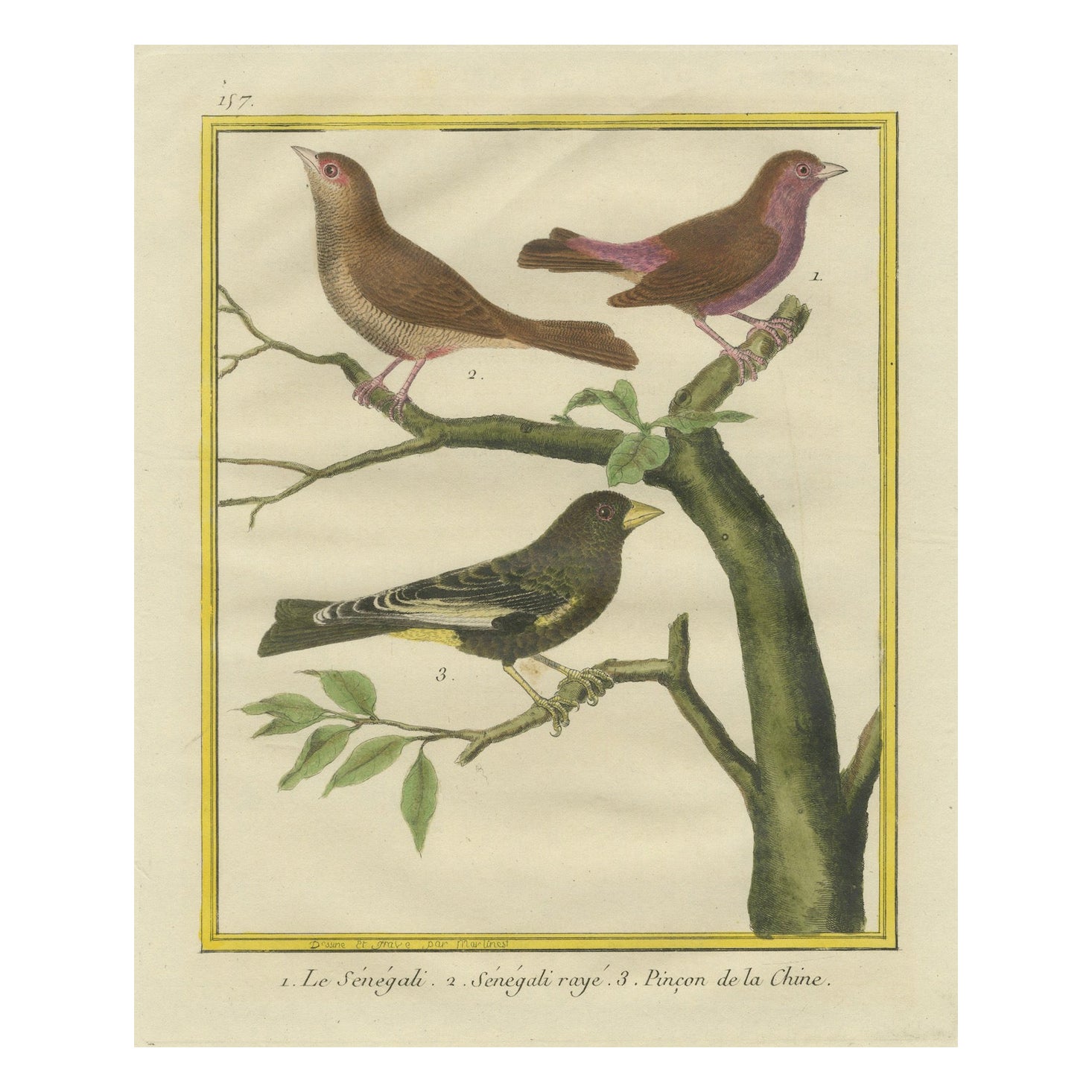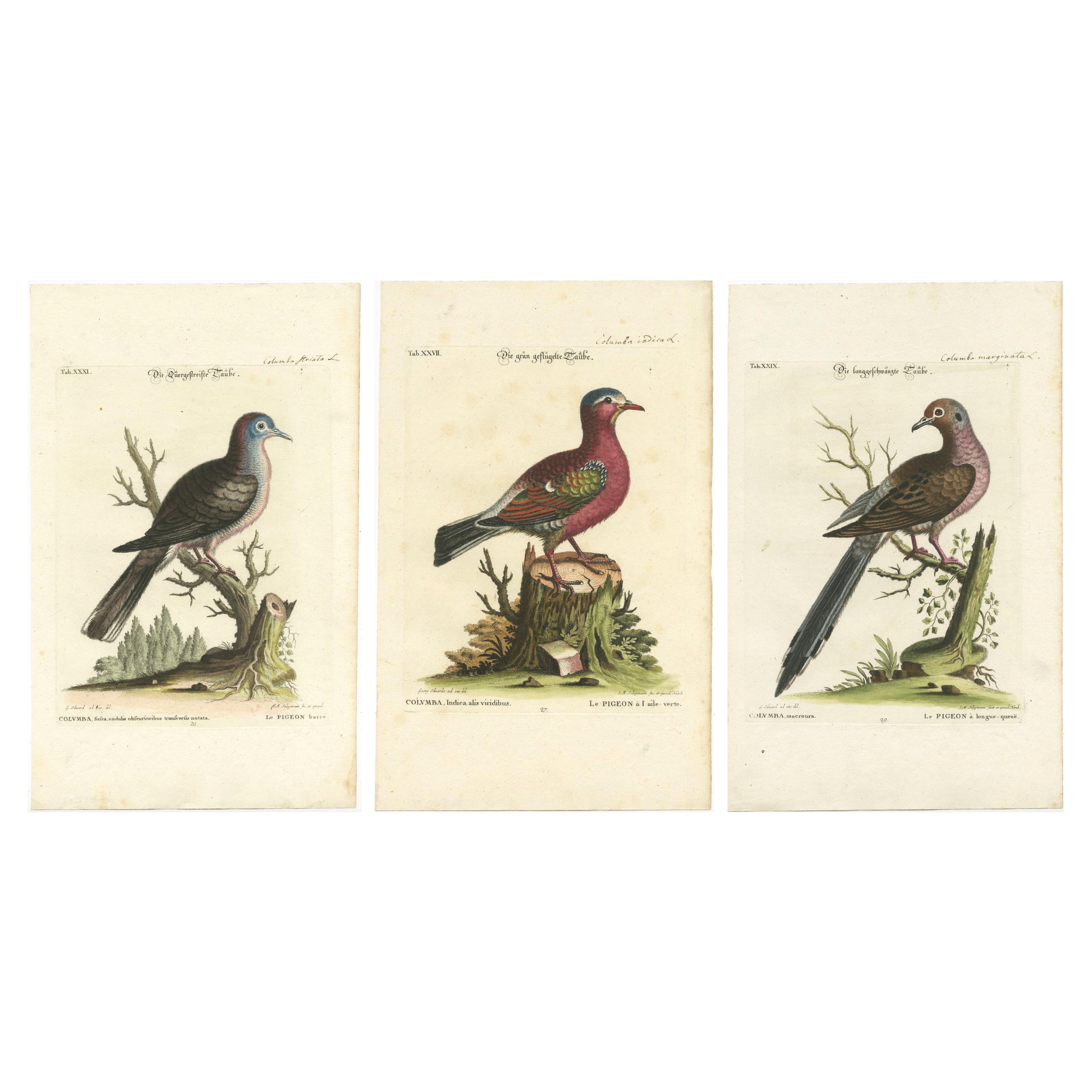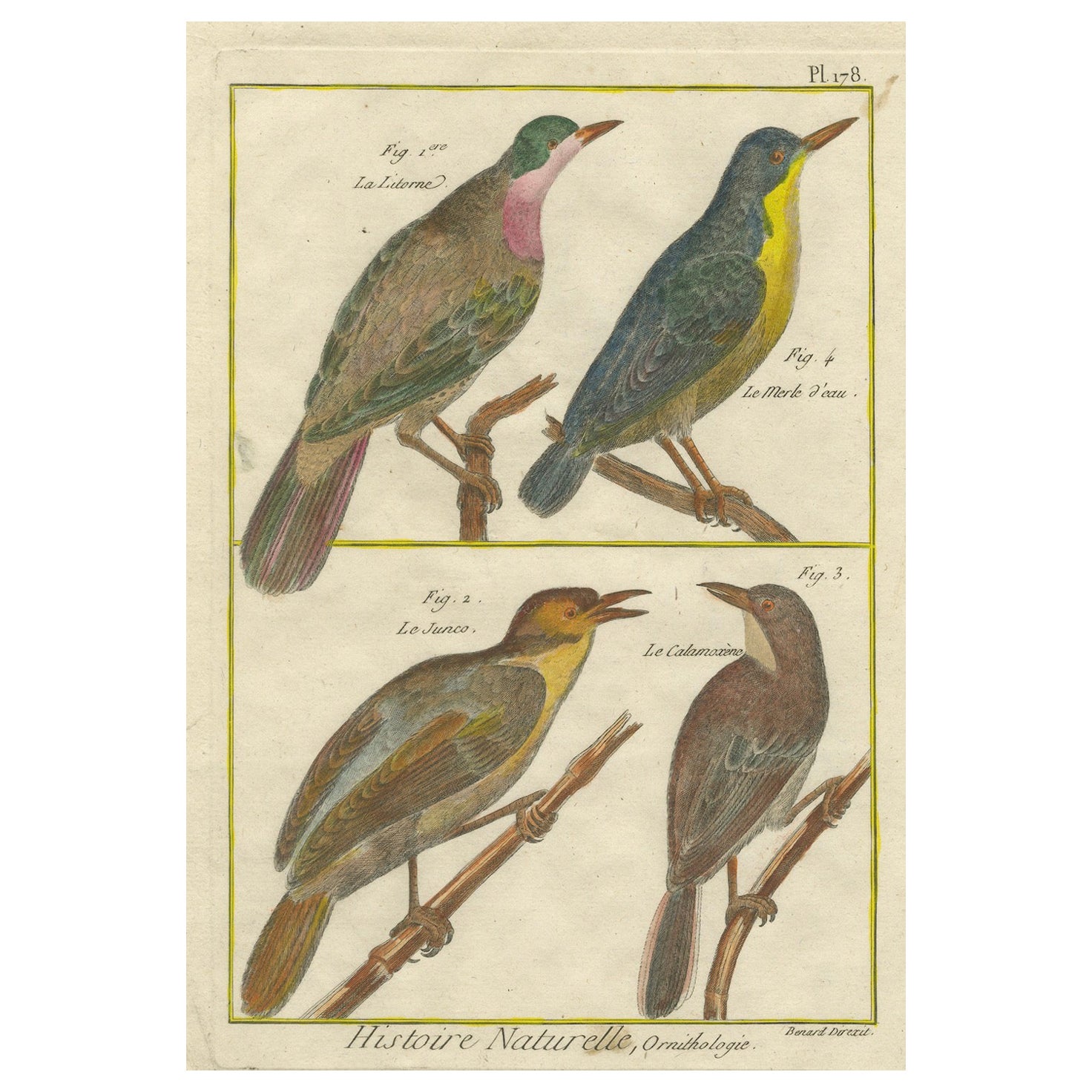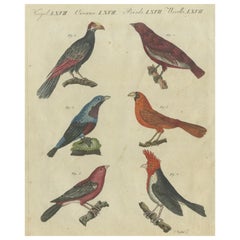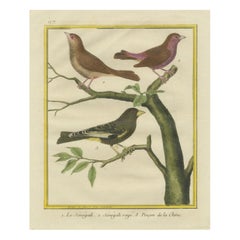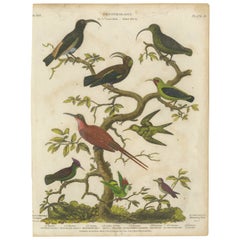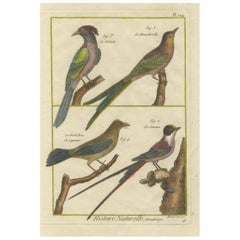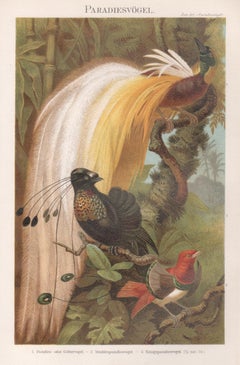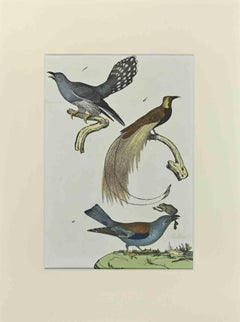Items Similar to Stunning Birds of Paradise from Seligmann's Rare Birds Collection (1770-1773)
Want more images or videos?
Request additional images or videos from the seller
1 of 9
Stunning Birds of Paradise from Seligmann's Rare Birds Collection (1770-1773)
$1,341.47
$1,676.8420% Off
£994.10
£1,242.6320% Off
€1,120
€1,40020% Off
CA$1,831.36
CA$2,289.2020% Off
A$2,037.31
A$2,546.6420% Off
CHF 1,067.98
CHF 1,334.9820% Off
MX$24,895.46
MX$31,119.3320% Off
NOK 13,599.45
NOK 16,999.3220% Off
SEK 12,802
SEK 16,002.5020% Off
DKK 8,527.58
DKK 10,659.4820% Off
Shipping
Retrieving quote...The 1stDibs Promise:
Authenticity Guarantee,
Money-Back Guarantee,
24-Hour Cancellation
About the Item
These prints belong to an era when scientific expeditions were beginning to bring back exotic species from distant lands, inspiring a surge of interest in documenting and classifying them. The engravings are from Johann Michael Seligmann's *Sammlung verschiedener ausländischer und seltener Vögel* (Collection of Various Foreign and Rare Birds), a key work in the field of ornithology during the 18th century.
Historical Context:
1. Johann Michael Seligmann (1720-1762):
Seligmann was a German engraver and publisher from Nuremberg, a city known for its role in scientific and artistic publishing during the Enlightenment. His engravings were often made after the works of other prominent naturalists and artists, especially those from Britain and France, which were at the forefront of scientific discovery at the time.
2. George Edwards (1694-1773):
These particular bird illustrations are after the works of George Edwards, an eminent British naturalist and ornithologist often referred to as the "father of British ornithology." Edwards published *A Natural History of Uncommon Birds* between 1743 and 1751, and its subsequent supplements were extremely influential. The German edition, in which Seligmann was involved, expanded on Edwards’ work and introduced these birds to a continental European audience.
3. Birds of Paradise in Natural History:
Birds of Paradise, native to New Guinea and nearby islands, have fascinated European naturalists since the 16th century. They were often brought back by explorers, but only as skins or stuffed specimens, leading to many myths about these birds. It was believed they had no legs and remained aloft their entire lives, hence the name "paradise bird" for their presumed otherworldly nature. By the time of these prints, more accurate representations were emerging, and artists like Edwards and Seligmann played a crucial role in disseminating realistic depictions.
4. Style and Technique:
These are 'altkolorierte Kupferstiche' or "old-colored copper engravings," a technique wherein the prints were colored by hand after they were engraved. Copper engraving was a meticulous process where an artist would incise a design into a copper plate, which was then inked and pressed onto paper to create the print. Afterward, skilled colorists would hand-tint the prints, as seen here with the vibrant reds, yellows, and greens of the birds.
5. Publication:
Seligmann's collection, published between 1749 and 1776, is significant because it combined Edwards’ groundbreaking ornithological studies with other sources, including the works of Mark Catesby and others. It helped broaden the scope of ornithological knowledge in Europe and added a German perspective to a primarily English and French-dominated field.
Individual Birds Depicted:
1. "Der sogenannte König der größeren Paradiesvögel" (King of the Greater Birds of Paradise):
This species is likely based on the *Paradisaea apoda* or Greater Bird of Paradise, which is famous for its bright plumage and impressive courtship displays. It was among the first to be described and became an icon of exoticism in European natural history.
2. "Der große Paradiesvogel" (The Great Bird of Paradise):
This bird features the extravagant feathers typical of the species, which play an essential role in their mating rituals. Artists and naturalists were often captivated by their long flowing feathers and striking appearance, making them a popular subject in natural history collections.
3. "Der goldene Paradiesvogel" (The Golden Bird of Paradise):
This bird might correspond to the *Lesser Bird of Paradise* or a similar species, known for its bright yellow and red colors. The print includes both the bird and surrounding flora, showcasing the connection between animals and their habitats, a hallmark of Enlightenment-era natural history illustrations.
Importance:
Seligmann's work reflects a broader European enthusiasm for understanding the natural world, which coincided with the Age of Enlightenment. These prints are both scientific documents and artistic masterpieces, bridging the gap between science and art. The exotic nature of the Birds of Paradise, their distant habitats, and their unfamiliar behaviors made them highly coveted subjects for European naturalists and collectors. Additionally, these prints contributed to the growing field of taxonomy, helping to classify and name the immense diversity of species being discovered in the 18th century.
### 1. **Printing Techniques in 18th-Century Natural History Engravings**:
During the 18th century, the art of natural history illustration reached new heights due to advancements in both printing technology and the growing scientific curiosity that characterized the Enlightenment. The method used in the prints you shared—hand-colored copper engravings—was a standard technique employed for high-quality, detailed illustrations, especially in natural history.
#### Copper Engraving Process:
- Engraving the Plate: A skilled artist would carve the image onto a smooth copper plate using a variety of tools, including burins. This was a delicate process, requiring precision to capture the fine details of feathers, textures, and botanical elements. The engraving would create grooves in the plate, which would hold ink when printed.
- Inking and Printing: Once the plate was carved, it would be coated with ink and then wiped so that the ink remained only in the engraved lines. A damp sheet of paper would be pressed onto the plate using a printing press, forcing the ink from the grooves onto the paper to produce the image.
- Hand Coloring: The resulting black-and-white print would then be colored by hand. This task was often carried out by specialized colorists, who used watercolors to carefully add vibrancy and life to the engravings. In natural history illustrations like these, the colorists aimed to reproduce the natural colors of the birds and plants as accurately as possible, although sometimes artists took slight creative liberties for aesthetic reasons.
Hand-coloring was labor-intensive and expensive, but it added immense value to the print, which was essential for capturing the intricate beauty of birds like those in the *Birds of Paradise* series.
Why Copper Engraving?
Copper plates were preferred because they allowed for finer detail than woodcuts or earlier methods. Engravings could capture the delicate features of a bird's feathers, the texture of foliage, and the overall dynamic composition that made these prints both scientifically valuable and visually appealing.
dditional Techniques:
Sometimes, later in the century, "aquatint" or "etching*"was used in combination with copper engraving to produce tonal effects and more nuanced shading. However, for prints like these, where fine lines and sharp detail were crucial, copper engraving remained the dominant technique.
2. Historical Reception of Natural History Prints:
Natural history illustrations were central to the Enlightenment's "scientific revolution," a time when European intellectuals sought to classify and catalog the natural world in an unprecedented manner. Here's how prints like Seligmann's were received:
A. Role in Scientific Discovery:
These prints were not merely decorative—they were crucial in advancing the science of "taxonomy", the classification of organisms. At this time, explorers and naturalists like "Carl Linnaeus" were developing systems to name and organize species, and illustrations helped in making these scientific distinctions clear.
- "Birds of Paradise": Prints like the ones you're looking at helped convey detailed information about species that few people in Europe could ever see in real life. For example, it was these kinds of works that contributed to the broader European understanding of the *Birds of Paradise*, as specimens had been brought back from Southeast Asia and New Guinea. However, since many specimens arrived in incomplete or stuffed forms, illustrations played a key role in clarifying their physical features.
- "George Edwards and Johann Seligmann": The work of Edwards, illustrated in these prints, was groundbreaking. Edwards' careful attention to detail and his commitment to natural accuracy became a model for future ornithological works. Seligmann’s engravings helped bring these works to a broader German-speaking audience, thus spreading this knowledge beyond Britain and France.
B. "Artistic and Aesthetic Value":
At the same time, natural history prints were prized as objects of **artistic beauty**. Wealthy collectors and scholars filled their libraries with ornithological works, both for their scientific content and their visual appeal. The prints, often sold in limited edition volumes, became collector's items, and natural history illustration became a prestigious artistic genre.
- Fusing Art and Science: These works sit at the intersection of art and science, exemplifying the Enlightenment belief that beauty and order existed in the natural world and could be captured through careful observation. Collectors would often display individual prints in their homes, and they were highly valued as decorative objects.
C. Influence on Later Artists and Naturalists:
Illustrations like these influenced not only scientists but also artists, who drew inspiration from the exotic beauty of foreign species. Artists like **John James Audubon** in the 19th century would build on this tradition, producing their own famous works that combined ornithological detail with artistry.
- Publication and Spread: The prints from Seligmann’s collection were widely circulated in elite scientific circles and were influential in both continental Europe and Britain. The publication of such works often involved significant collaboration between artists, engravers, and naturalists, reflecting the interdisciplinary nature of Enlightenment-era knowledge production.
Legacy in the Broader European Tradition:
A. **Ornithological Tradition**:
Seligmann’s work is part of a long European tradition of ornithological illustration that began with artists like **Conrad Gessner** in the 16th century and continued with great works like **Audubon’s Birds of America** in the 19th century. This tradition sought not only to capture the physical likeness of birds but also to provide valuable information about their behavior, habitat, and place in the natural world.
- **Scientific Utility**: These prints were often used as references by other naturalists, botanists, and explorers, and they helped popularize and disseminate scientific knowledge. The visual representation of a species was sometimes the only way for a scientist in Europe to study exotic creatures.
B. **Economic and Cultural Impact**:
Natural history illustration, especially involving exotic species like the Birds of Paradise, fueled European desires for exploration and expansion. Colonies and trade routes often emerged from the same impulses that led to scientific discoveries, and prints like these symbolized the growing European dominance over the knowledge and resources of distant lands.
Conclusion:
The hand-colored copper engravings of Birds of Paradise by Johann Seligmann and based on George Edwards' originals represent a confluence of artistic skill and scientific advancement. These prints were not only tools of scientific inquiry but also prized for their aesthetic beauty. They played an important role in disseminating knowledge about the natural world, particularly about exotic species that captivated European imagination.
The intersection of fine art, meticulous engraving technique, and scientific observation made these works influential in the history of ornithology and natural history, setting a standard for the way flora and fauna were documented and appreciated both scientifically and culturally.
- Dimensions:Height: 14.97 in (38 cm)Width: 9.65 in (24.5 cm)Depth: 0 in (0.02 mm)
- Materials and Techniques:Paper,Engraved
- Period:1770-1779
- Date of Manufacture:circa 1770
- Condition:Condition: Very good. Vibrant colors, minimal fading. Paper shows light toning and minor foxing in margins. Edges sharp; no tears or folds. Slight handling marks, not affecting image quality.
- Seller Location:Langweer, NL
- Reference Number:Seller: BG-13946, -47, -481stDibs: LU3054341684802
About the Seller
5.0
Recognized Seller
These prestigious sellers are industry leaders and represent the highest echelon for item quality and design.
Platinum Seller
Premium sellers with a 4.7+ rating and 24-hour response times
Established in 2009
1stDibs seller since 2017
2,502 sales on 1stDibs
Typical response time: <1 hour
- ShippingRetrieving quote...Shipping from: Langweer, Netherlands
- Return Policy
Authenticity Guarantee
In the unlikely event there’s an issue with an item’s authenticity, contact us within 1 year for a full refund. DetailsMoney-Back Guarantee
If your item is not as described, is damaged in transit, or does not arrive, contact us within 7 days for a full refund. Details24-Hour Cancellation
You have a 24-hour grace period in which to reconsider your purchase, with no questions asked.Vetted Professional Sellers
Our world-class sellers must adhere to strict standards for service and quality, maintaining the integrity of our listings.Price-Match Guarantee
If you find that a seller listed the same item for a lower price elsewhere, we’ll match it.Trusted Global Delivery
Our best-in-class carrier network provides specialized shipping options worldwide, including custom delivery.More From This Seller
View AllVibrant 1805 Handcolored Engraving of Tropical Birds from Bertuch's Bilderbuch
Located in Langweer, NL
Title: Vibrant 1805 Handcolored Engraving of Tropical Birds from Bertuch's "Bilderbuch für Kinder"
Description: This vibrant handcolored engraving from 1805 features six tropical ...
Category
Antique Early 1800s Prints
Materials
Paper
Exotic Birds of the World: A 1765-1780 Study by Martinet and Buffon
Located in Langweer, NL
This image is an exquisite hand-colored engraving from the "Histoire Naturelle des Oiseaux," a seminal work published between 1765 and 1780. The artist behind this detailed work is F...
Category
Antique 1770s Prints
Materials
Paper
$297 Sale Price
20% Off
Diverse Avian Species: An early 18th-Century Ornithological Study, 1811
Located in Langweer, NL
The image is an ornithological print from the early 19th century. It depicts various species of birds perched on branches. The birds are illustrated in vibrant colors with a high lev...
Category
Antique Early 18th Century Prints
Materials
Paper
$277 Sale Price
20% Off
Hand-Colored Engraving of Exotic Tropical Birds from Histoire Naturelle, 1790
Located in Langweer, NL
This is an hand-colored copperplate engraving by Robert Benard, part of the *Histoire Naturelle* from the *Encyclopédie Méthodique*, circa 1790. The illustration features four exotic...
Category
Antique 1790s Prints
Materials
Paper
$124 Sale Price
20% Off
Exotic Pigeons: Hand-Colored Engravings from the Seligmann Edition, c.1770
Located in Langweer, NL
Title: Exotic Pigeons of the World: Hand-Colored Engravings from the Seligmann Edition, After George Edwards’ Natural History
This set of three beautifully detailed hand-colored eng...
Category
Antique 1770s Prints
Materials
Paper
$847 Sale Price / set
30% Off
Hand-Colored Engraving of European & Exotic Birds from Histoire Naturelle, 1790
Located in Langweer, NL
This hand-colored engraving is attributed to Robert Benard (1734-1786) and originates from the *Encyclopédie Méthodique*, published around 1790. It showcases four different birds, de...
Category
Antique 1790s Prints
Materials
Paper
$124 Sale Price
20% Off
You May Also Like
Francois Nicholas Martinet Bird Engraving, circa 1770
By François Nicolas Martinet
Located in Downingtown, PA
Francois Nicholas Martinet bird engraving,
circa 1770.
The framed Francois Martinet engraving is from Buffon's Historie Naturelle des Oiseaux displa...
Category
Antique 1770s French Georgian Prints
Materials
Paper
Birds of Paradise, German antique natural history chromolithograph print
Located in Melbourne, Victoria
'Paradiesvogel'
(Birds of Paradise)
German chromolithograph, circa 1895.
240mm by 155mm (sheet)
Category
Late 19th Century Naturalistic Animal Prints
Materials
Lithograph
Birds with Particular Tail - Etching by Johann Friedrich Naumann - 1840
Located in Roma, IT
Birds with Particular Tail is an Etching hand colored realized by Gotthilf Heinrich von Schubert - Johann Friedrich Naumann, Illustration from Natural history of birds in pictures, p...
Category
1840s Modern Figurative Prints
Materials
Etching
Johann Seligmann Bird Print, Le Colibri rouge & Le petit Colibri brun, Tab LXIII
By Johann Michael Seligmann
Located in Downingtown, PA
Johann Seligmann Bird Print,
Le Colibri rouge & Le petit Colibri brun,
Tab LXIII
Circa 1770
The Johann Seligmann engravings of two birds on a branch- Le Colibri rouge & Le petit Co...
Category
Antique 1770s German Georgian Prints
Materials
Paper
19th Century John Gould Bird Print - One of 24
By John Gould
Located in Atlanta, GA
Mr John Gould's tropical framed Bird prints 1955 taken from his limited edition of 1000.
The most celebrated British ornithologist of the nineteenth-century
John Gould (1804-1881) ...
Category
Antique 19th Century English Victorian Prints
Materials
Paper
Johann Seligmann Bird Print of Le Pivert Mouchese des Indes, Tab LXXVII
By Johann Michael Seligmann
Located in Downingtown, PA
Johann Seligmann Bird Print,
Le Pivert Mouchese des Indes,
Tab LXXVII,
Circa 1770
The Johann Seligmann engravings of Le Pivert Mouchese des IndesTax LXXXVII is mounted in a decoupa...
Category
Antique 1770s German Georgian Prints
Materials
Paper
More Ways To Browse
George Edwards Engravings
Library Catalog
George Edwards Bird Prints
Bird Of Paradise Feathers
Gio Ponti Display Cabinet
Glass Door Etagere
Glass Ginger Jar
Goryeo Celadon
Granite Buddha
Gun Cabinet
Hay Dining Table
Japanese Parasol
Joe Colombo For Kartell
Kerala Antique
Meissen Dinner Set
Metal Mesh Cabinet
Mustard Jars
Nut Dish

